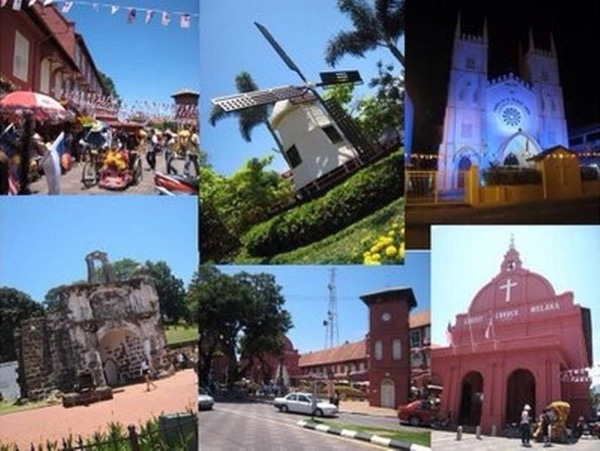Saturday November 5, 2011
What tree did Parameswara really see in Malacca?
INTERACTIONS
By FRANCIS NG
IT is taken as a historical fact that Malacca was founded by Parameswara, who named it after the melaka tree. Parameswara, in the legendary account of the founding of Malacca, actually had no idea what the tree was.
He had seen a mouse deer kick one of his hunting dogs and, inspired by the fighting spirit of the mouse deer, he asked his followers “What is the name of the tree under which I am standing?” His followers replied “It is called melaka, your Highness”. Nobody said “Wait, let us check this out.”
I would like to present evidence that Parameswara was wrongly advised. Before anybody questions whether I am qualified to change history, let me explain that my comments are based on botany, and I am, after all, a qualified taxonomic botanist, one who deals with the naming and classification of plants.
The melaka tree, known in Sanskrit as amalaka', has an ancient and venerable history in Sanskrit culture and medicine.
What’s in a name? Phyllanthus pectinatus is native to Malacca but is often mistaken for Phyllanthus emblica from which Malacca is believed to have gotten its name.
When the Swedish founder of modern plant classification, Carolus Linnaeus, gave this tree its scientific name in 1753, he Latinised amalaka' to emblica' and placed it within the genus Phyllanthus. Hence the melaka tree became known in science as Phyllanthus emblica. Phyllanthus emblica is now planted all over Malacca as the state's iconic foundation tree.
However, what Parameswara saw must have been another species, Phyllanthus pectinatus, which has a superficial resemblance to Phyllanthus emblica.
Phyllanthus pectinatus was first described and named by Joseph Dalton Hooker in 1890, based on specimens collected in Perak, Malacca and Singapore.
I first became aware of the possible mis-identification when I planted melaka' trees in FRIM (Forest Research Institute Malaysia), some from seeds collected in a forest, and some from seeds collected from a garden.
When the trees grew and produced flowers and fruits I found that they represented two utterly different species. These differences are obvious when specimens of the two species are placed side by side for comparison.
In Phyllanthus emblica, the fruits are clustered at the base of rather robust leafy shoots whereas in Phyllanthus pectinatus they sway in the wind at the ends of the finely feathery leafy shoots.
Inside the fruit is a hard stony structure containing the seeds. This stony structure is sharply 3-angled in Phyllanthus pectinatus but rounded in Phyllanthus emblica. There are also differences in flower structure and in the appearance of the bark.
In trying to figure out the relationship between the two species, I checked the specimens of melaka' preserved at the herbarium of FRIM.
A herbarium is a place in which specimens collected by plant explorers are permanently preserved for scientific study and reference.
The FRIM herbarium serves as the national herbarium for Malaysia and it has specimens from all over the country, collected by botanists and foresters during the past 100 years of forest exploration. All the specimens of melaka' in FRIM were of Phyllanthus pectinatus.
When I had the opportunity to visit the world herbarium at Kew, I examined the collections from all over Asia, including the specimens seen by Joseph Dalton Hooker. I also went to the Botanic Gardens Singapore to check the specimens in its herbarium.
Putting all the information together, the picture that emerged was that Phyllanthus emblica has its natural range across India, Burma, Thailand, Indo-china and South China.
In contrast, Phyllanthus pectinatus has its natural range within the Malay Archipelago, especially in Sumatra, Malay Peninsula and Borneo. In their natural state, there is no geographical overlap between the two species.
In brief, Phyllanthus pectinatus is a true forest tree of the Malay Archipelago and it is particularly common in the forests of Malacca state.
In contrast, Phyllanthus emblica occurs only as a planted garden tree in the Malay Peninsula and the rest of the Malay Archipelago. It has never been able to escape and establish itself in our forests.
The best place to see Phyllanthus pectinatus is in the recreational forest of Ayer Keroh just outside the city. This area is now being redesignated as a botanical garden, but its core area is maintained as natural forest.
In this forest, there are many natural trees of Phyllanthus pectinatus, prominently mislabelled as Phyllanthus emblica. Just outside the forest, the true Phyllanthus emblica has been planted prominently in various locations for visitors to see.
Nobody has noticed that the native trees in the forest are a different species from the planted trees outside. What Malacca needs is a botanist, ideally a taxonomist cum horticulturist, to manage its botanical garden.
Malacca may have to accept that it has two iconic foundation trees: the tree that Parameswara saw and misidentified, and the tree it got mistaken for.
To me, the native tree is the more attractive of the two.
● Botanist and researcher Francis Ng is the former deputy director-general of the Forest Research Institute of Malaysia. He is now the botanical consultant to Bandar Utama City Centre Sdn Bhd and the Sarawak Biodiversity Centre. (fng@pc.jaring.my)

No comments:
Post a Comment